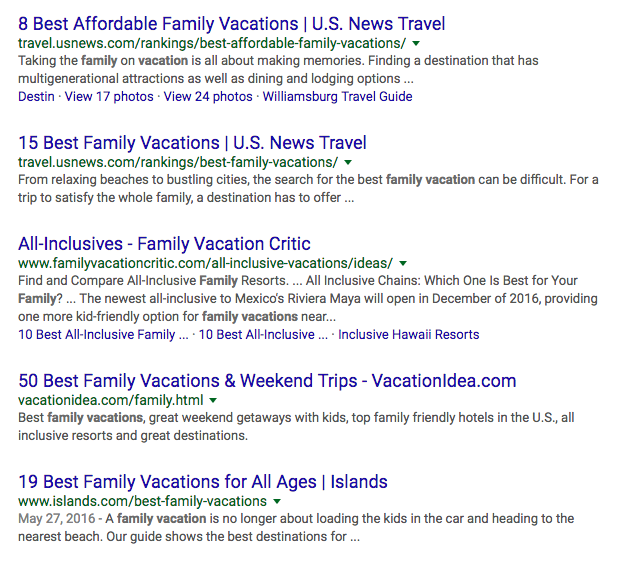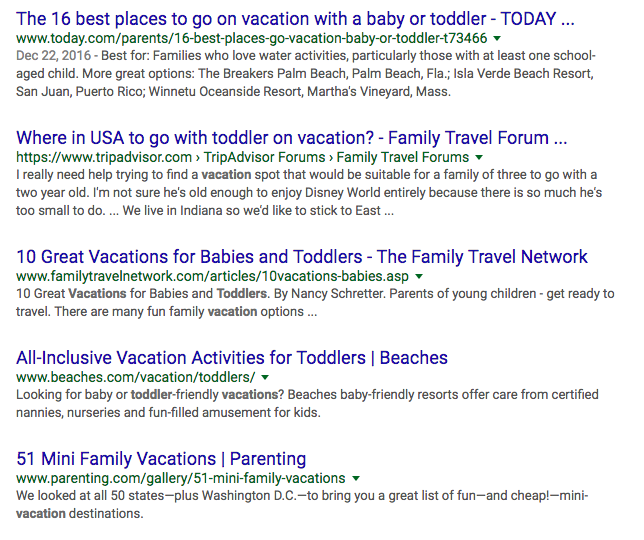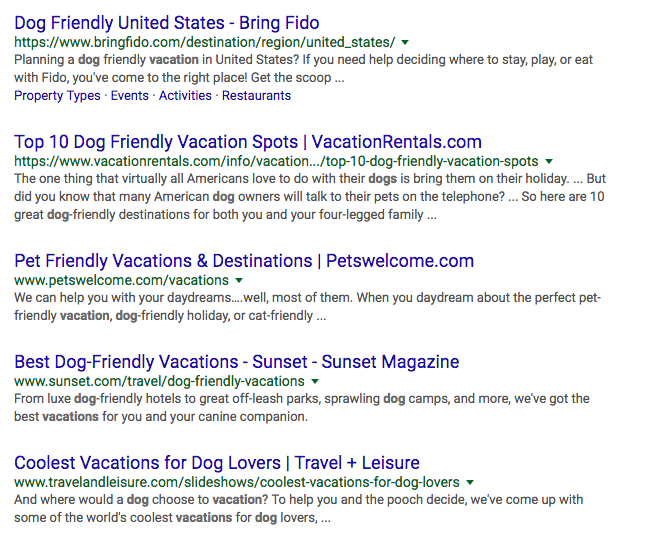For a while now, many practitioners in the professional SEO circles have been talking about holistic content. The idea behind holistic content is to create a page (URL) and have an extensive amount of information on a specific topic on that one page, in order to supply the best possible answer to a search query. Instead of having multiple individual pages for each exact keyword within the topic, you create one exhaustive page with all the possible information.
- Reasons for Holistic Content
- The Magic Words are "Appropriate" and "Topic"
- Title Tag and Meta Description Constitutes the Boundaries of Holistic Content
- Should I Bundle-Up Content on my Page?
- Long Texts Are Not Automatically Better
- Think About Usability and Structure Long Texts Well
- For Every Trend There is a Counter Trend
- Conclusion: Good Content Does Not Equal Holistic Content
Reasons for Holistic Content
This development has two main causes:
- Google is increasingly getting smarter and can understand search querys better. Google is already better (e.g. with RankBrain) at understanding that similarly worded search queries share the same search intent and then bundling them together. Wording your search query in a slightly different way will no longer lead to substantially different search results. Due to this, it is possible to bundle that content instead of having individual pages for each search query.
- User signals are playing an increasingly larger role at Google. By not depending exclusively on links anymore – and by simultaneously exposing spamlinks much better – Google is noticeably increasing the resulting quality of their quality assessment for content. Google will reward high quality content creation much more often with high rankings than just a few years ago.
The Magic Words are “Appropriate” and “Topic”
Trying to make the holistic text as exhaustive as possible sometimes escalates into very long texts with thousands of words. Even the briefings for these texts will often give the impression that length had the highest priority and not quality. The thing is, both quality and added usefulness will not automatically increase with the length of a text. The magic words are “topic” and “appropriate”. You should always stick to the topic – aside from fundamental quality criteria – and the length should be appropriate, depending on the search intent of your user.
As an example, let us take a look at the keywords “family vacation”, “vacation with children”, “vacation with infants”, “vacation with toddlers” and “vacation with dogs”.
Should we provide one holistic page for these five keywords – with all the information bundled together – or should we rather create five individual pages, one for each keyword?
We get the first answer by looking into the search results themselves. If we look at the top results for these keywords, we see they are quite different and there is very little overlap:
There is a good reason for Google to have different pages as the top results for these keywords. The magic word, in this case, is “topic”. Going on vacation with a toddler or with a dog are two very different topics. Lodgings and tips that are well suited for a vacation with toddlers are not automatically a good fit for anyone taking their dogs on vacation, or vice versa. The same holds true even for “vacation with children” and “vacation with infants”. If you try to cram all of it on one page, you will lose focus.
Title Tag and Meta Description Constitutes the Boundaries of Holistic Content
We need to remember that we can only supply each page with on title tag and one meta description. These two elements, together with the URL, are usually what Google uses to create their search result snippets.
Having a great ranking is rather useless if only few users click on it simply because the title and description were too generic and not relevant enough. Additionally, having poor user signals will make it impossible to keep those rankings, in the first place. This puts a natural boundary on holistic content.
There is no other place that these boundaries become so apparent as with the title and the description. There is a clear danger that your result will seem less relevant compared to other search results which are more focussed.
In our example, it might therefore be a good idea to create a summary-page for the main topic “family vacation” and then link to sub-pages for the different topics “vacation with children”, “vacation with toddlers”, vacation with infants”, and “vacation with dogs”. This way, you can provide a unique and individual title and meta description for every page. This keeps you on topic and the users can quickly figure out the relevance.
Should I Bundle-Up Content on my Page?
There is mostly consensus in the SEO-industry that you do not need to systematically provide an individual page (URL) for each and every keyword on your keyword list, which discusses that exact keyword. Instead, today, words will be grouped into specific topics and that topic will get a comprehensive text on its own page.
Bygone are the days where you would create a new page in the following situations:
- for different wordings such as “football boots” and “boots football”
- for filler words such as “Football London” and “Football in London”
- for synonyms like “Arsenal fans” or “Gooners”
- keywords with a very low search volume, such as “number of teams in the northern premiere league division one north”, would become part of a page on “number of teams in the English football league system” or maybe even turn into a facet of “English football rules”.
Long Texts Are Not Automatically Better
Recommendations that claim to be universally valid, such as “you need a minimum of XXX words” are utter nonsense and generally bad advice. It may be true that longer texts are often of higher quality and higher quality will often be accompanied by better rankings. This does, however, not mean that a long text is always the ideal choice, no matter what. There are many examples of where a short text is the best answer.
We can use a statistics example to show the fallacy of such a pseudo-scientific approach. The average hight for all Manchester United players in the 2017 season is 183cm. The question now would be if it would be best to only use players that are at least 1,83 meters tall? That way, ManU would have to pass up using Wayne Rooney (with his height of 176cm). Just because many of the players are tall does not mean that players with a below-average height are unable to be successful. This inversion is not valid and can be debunked in practice. The text length is a similar story.
There are a number of search queries where short and very precise texts are, hands down, the best answer. It is not without reason that Google is showing Featured Snippets and One-boxes – which sufficiently answer the search query for the user right in the search results – in increasing numbers. For other search queries, the user might rather see a picture, graphs, tables, shopping results or a video instead of having to read a long text.
The authority that will decide which answer is the best is ultimately the user. To get a good hint on which answer might be the best you can use common sense and take a look at the current top results on Google for that specific keyword.
Think About Usability and Structure Long Texts Well
If you do decide on a long text then please make sure that it is structured well, so that the different sub-topics can be easily found. Both table of contents – as the Wikipedia is using for example – as well as sub-headings have proven to be very useful for this.
We live in a time in which more than half of all search queries on Google are made from mobile devices, which makes it extremely important that your texts can also be read well on a smartphone and that it will load quickly.
For Every Trend There is a Counter Trend
While there are currently a large number of website owners who try to produce holistic content with extremely long texts, the pendulum will eventually swing the other direction. If more and more long texts become available, then the users will automatically have a demand for short and concise answers (Snackable Content). Every trend has its counter trend. Filling the niche for snackable content for a topic – and not leaving the field to the Google One-Boxes – might therefore be a successful strategy.
Conclusion: Good Content Does Not Equal Holistic Content
You would not create individual pages anymore for different wordings, filler words, synonyms or keywords with a very low search volume, that have a topical overlap with other pages. Instead, you would bundle those on one page (URL). When doing this it is very important to stay focussed and not include different topics on the same page, as this might cost the page its relevancy for a topic. This becomes apparent when we get to the title and meta description, which you can only assign once per page. This makes it hard to hit numerous topics spot on with them.
Your content on a specific topic should have the appropriate length for that topic. Sometimes the best answer will be a long text, sometimes it will be short. Different strategies may lead to your success. The basis for a successful strategy are not universal rules but a great analysis of the user intent (demand) paired with common sense.
If you systematically put the users and their needs front and centre, then you will automatically create content of the appropriate length. Your goal should not be to produce “holistic content” or “long texts”, it should be to produce “good content”. Good content can be holistic, but it does not have to be.



